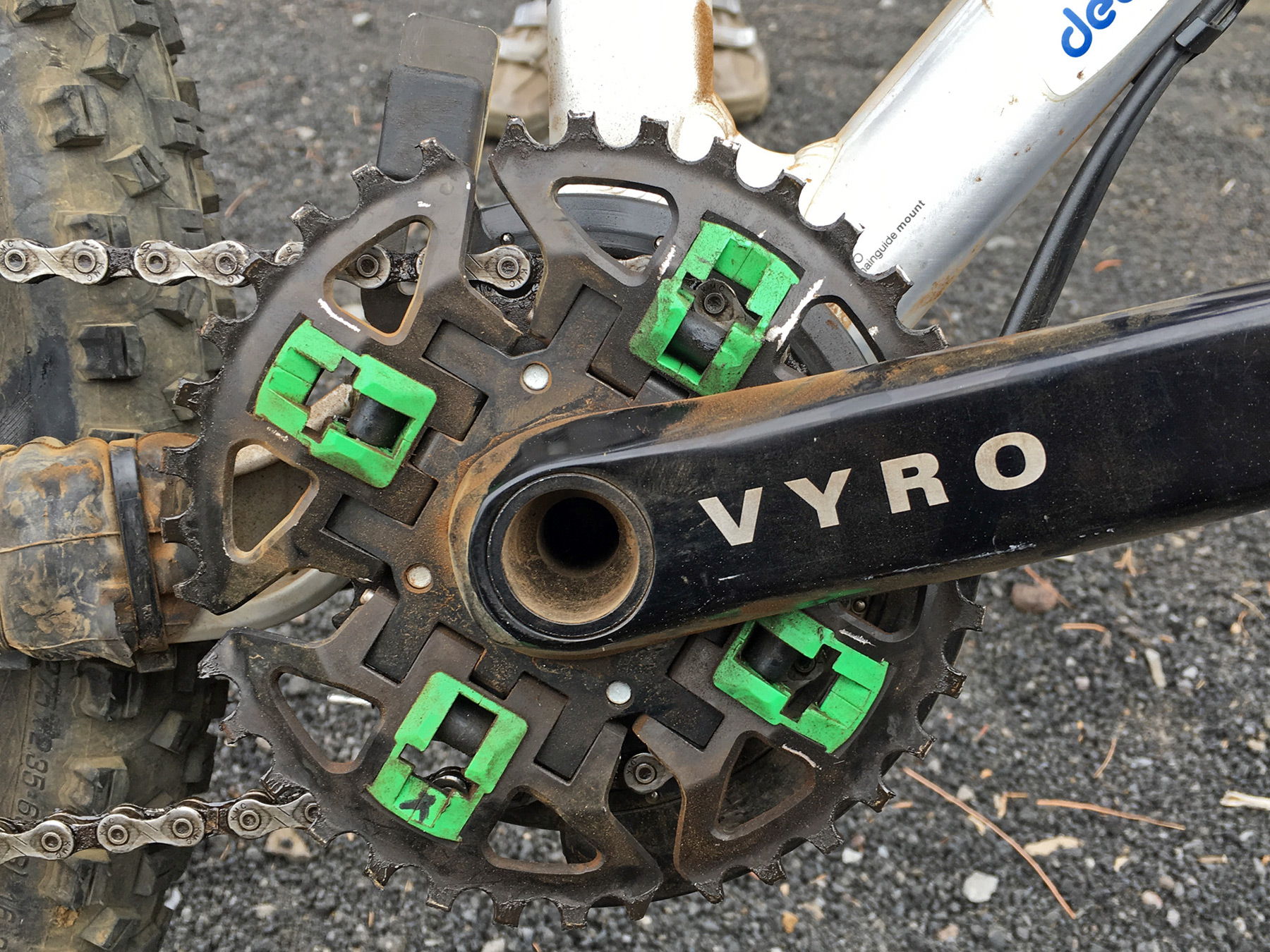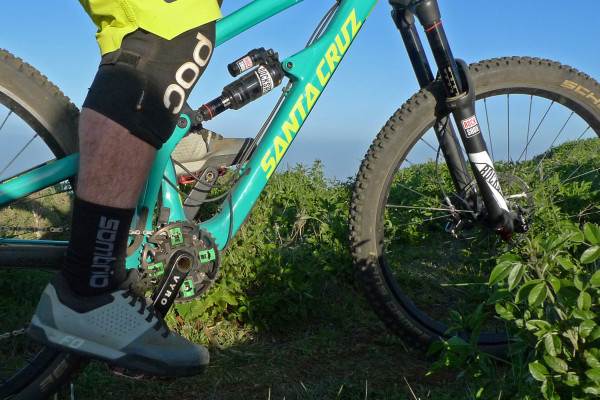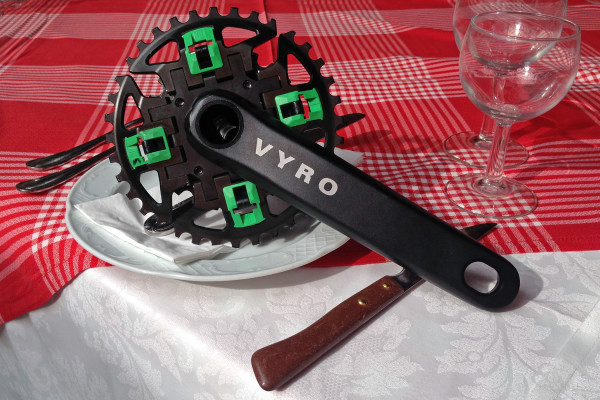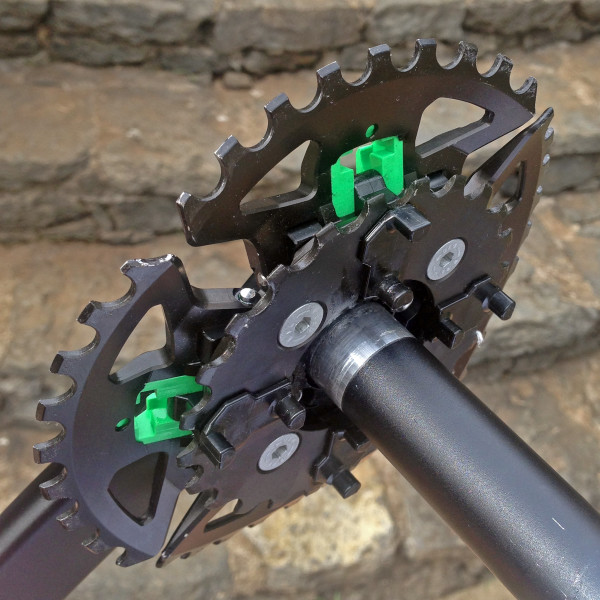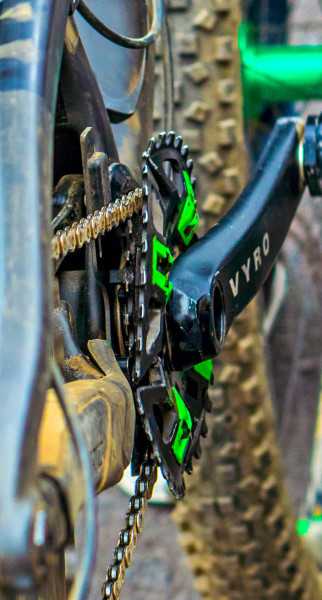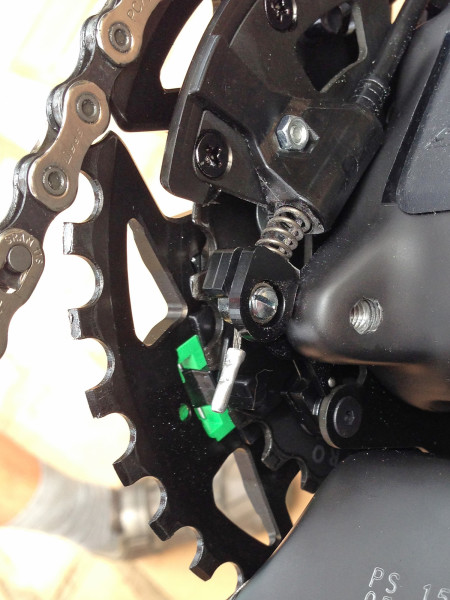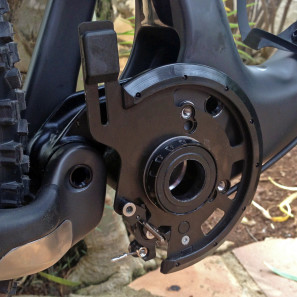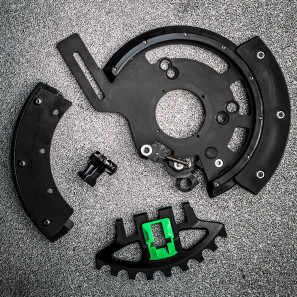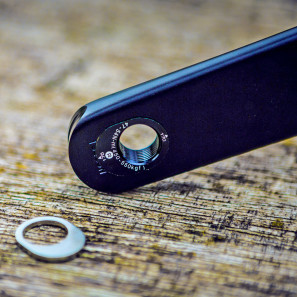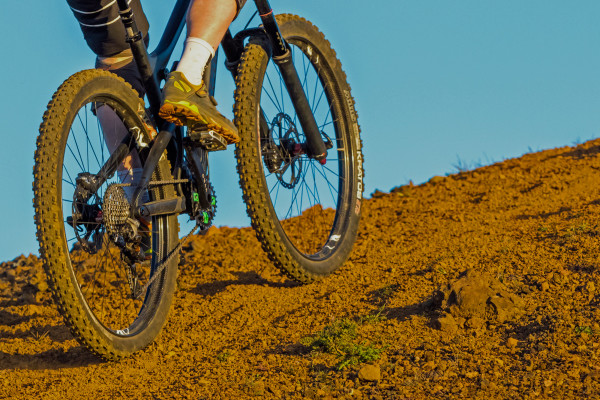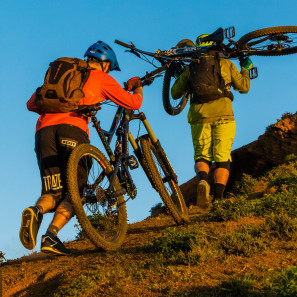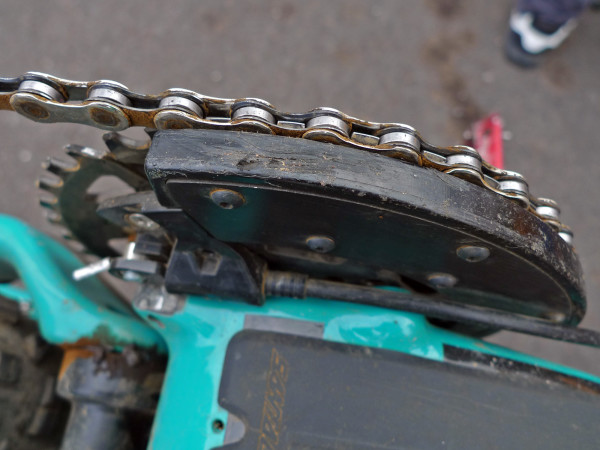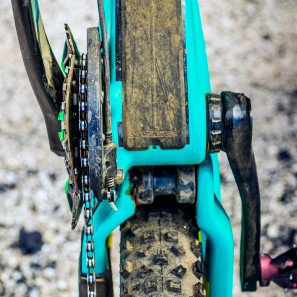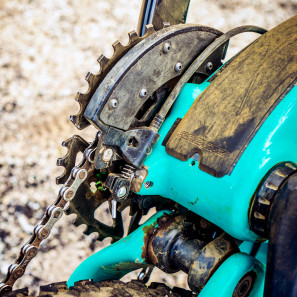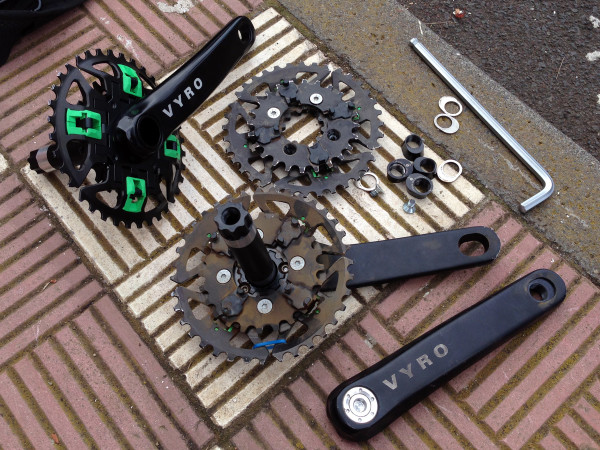It’s been almost four years since we first looked at the unique shifting crankset concept from Vyro, but now having just spent a week riding a pre-production version we have a better sense for their alternative crank that delivers some advantages over both 1x and double setups. By moving the big chainring in and out of the path of the chain, the Vyro AMEn1 crankset gives mountain climbing gearing and constant chainline in a relatively light package that doesn’t need a front derailleur. Plus of course the most important point is that the cranks are in production now, with availability just a short time away. Take a close look at how it works, some insight into what we thought about riding it and its ideal applications, plus full details on pricing and availability, all after the fold…
The idea for the crank goes back at least to 1994 when Austrian company founder Gregor Schuster was racing downhill. Based in Vienna, Vyro Components was founded as his proof of concept led to a crowdfunding boost back in 2012. Since then he has worked on developing the crank to a solution that could deliver all of his lofty goals of trying to outperform 1x, standard double, and gearbox crank setups. A clear goal of Schuster was also to keep as much production local, which resulted in all of the shifting mechanics being manufactured in Austria, while the crank arms and bottom bracket are produced in Asia.
The Vyro AmEn1 cranks (named for All-Mountain & Enduro) pair a fairly standard set of forged aluminum arms and 24mm alloy axle to the unique Vyro spider and chainrings. Attached to the spider are the four segmented elements of the big chainring, which rotate independently of each other, in-and-out on pinned titanium axles.
The green plastic guides control the chainring segments movement as they are pushed by plastic shifting sliders on the other side. What happens then is that the segments of the big ring can move in or out of the way of the chain, while the small ring stays fixed. That small ring bolts directly to the main spider (with green ano, countersunk ti hardware in the production version), and is shaped to allow four engineered plastic shifting sliders to slide up and down when moved by the shift actuator that is attached to the bike frame. As each slider moves past the actuator fixed near the bottom bracket, it slides up or down to change position of its segment of the big ring, either pulled down in line for big gearing or pushed out of the way for the small gear.
The Vyro AmEn1 crank works by moving one segment of the big ring at a time, always when it is not engaged with the chain. That means that shifting can happen when the cranks are completely under load. It also makes shifting fast. The crankset shifts as fast as you spin the crank arms. The actual shift only takes 1/4 rotation to engage the bigger or smaller gear, and you only have to wait for the next 1/4 of the crank to go around. That means that a full shift takes at most 1/2 turn of the cranks and at minimum 1/4 turn.
The sequence above illustrates a shift from big to small (from left to right):
- The crank engaging the big chainring.
- The first segment of the big ring has moved out of the way, yet the chain is still 100% engaged with the three remaining segments.
- Two of the big ring segments have moved out of the way and the chain is now partially engaged with the small ring, effectively pushing the smaller gear. The chain is still engaged with the last remaining big ring segment at the bottom of the crank.
- All of the big ring segments have moved out of the way for 100% engagement of the little ring.
The shifting action of the shifting sliders and then positioning of the big ring is moved by a cable-controlled actuator. Fitted at the bottom bracket on a backing plate fixed to the frame, in the open position (left) it will move the ring out of the way for a downshift. In its closed position (right) it keeps the big ring segments tucked inline with the chain for the harder gearing.
Setup & Riding Impressions
We rode the Vyro AmEn1 cranks on a series of carbon fiber Santa Cruz bikes and aluminum Bionicons. We had the chance to pair them with otherwise SRAM 1x 11 speed setups, Shimano 1x11s, both with clutched rear derailleur and SRAM 2×10 drivetrains without any chain tensioning mechanism. The terrain on El Hierro where we did the bulk of our riding could be called steep, rocky, and loose. So there were plenty of opportunities for getting in that tiny gearing to climb up some steep stuff, in order to bomb down the other side.
The Vyro AmEn1 comes now with only a 24/36T chainring set. Due to the way in which the 7005 spider and rings are segmented, pretty much any reasonable gearing combination is possible, but even toothed big ring sizes (or multiples of 4) make things easier to manage. 26/36, 22/36 & 22/38 ring options are said to be in the works as well this fall to cover everything from trail riding to enduro racing. We rode exclusively on the All-Mountain alloy spindle version that has an ~90kg weight limit (riding weight with gear). But a DH version using a chro-moly axle will be available with just a minor 60g penalty and no weight limit.
Shifting of the crank is done with any SRAM MTB double shifter. Vyro chose not to include a shifter since they think a lot of buyers will already have one if upgrading from an existing drivetrain. They will offer a SRAM shifter through their webshop for those who need one, and have been quite happy with the performance of the low cost X5 shifter. The AmEn1 setup is compatible with both 10 & 11 speed groups and works best with cassettes with a max cog of 40T as that still allows the rear derailleur to maintain chain tension.
In order to mount the back plate that holds the shifting actuator, a compatible frame must have either a threaded bottom bracket or an ISCG mount, and two separate back plates will be available at launch. In addition to hold the actuator, the back plate includes a set of inner chain retention sliders that guarantee chain retention, and a 65g removable bashguard to protect the segmented rings. The individual segments are replaceable (fairly easily and with no special tools when you follow the step-by-step instructions), and Vyro even includes an extra segment with each crankset to replace if one is damaged riding.
Where the AmEn1 lacks compatibility for now is with Boost bikes. The crankset is only available in one chainline offset that was optimized before the advent of Boost, so for those with a new Boost bike you should wait until an updated version is available soon.
The AmEn1 cranks get adjustable arm lengths care of a nice and simple pedal insert. Turn it around to go from 170-175, with a centered insert offering 172.5mm. The insert is keyed in place, and we didn’t have any issues with it in a week of riding, even when swapping pedals out each evening to try different bikes.
The splined alloy spindle setup we were riding has a claimed weight of 742g including the cranks, rings, bottom bracket, and backing plate with actuator (not the sold separately shifter). That puts the crankset with its unique rings just a shade under 500g. Vyro’s goal was to get weights for the setup to fall somewhere in between XT & XTR or X1 & XX1, while still being able to compete on price.
The first question with the cranks is probably why to change to them in the first place. For a lot of amateur riders and middle-aged guys with old knees 1x setups are a still a compromise. Single ring setups usually work great, but often times would benefit from changing chainring sizes depending on where and what type of terrain you are riding.
When on long tours or in really steep mountains like the Alps or northern Rockies, even the smallest 1x drivetrains lose a good bit of desired gearing range. Where we were riding on the steep slopes of a volcanic island, a granny gear combined with a 40T Shimano cog meant I could pedal a Nomad up the steepest imaginable ramps, and only very rarely had to get off the pedals.
As a lot of modern trail and enduro bikes have started to drop front derailleur compatibility in the interest of bigger tire clearance and short chainstays, the Vyro also becomes a viable alternative to claw back that gearing range. Then there is the shifting under full load benefit, which is hard to appreciate if you have gotten used to letting off as you pedal on cross-country trails. But on trails with abrupt changes in terrain the ability to drop gearing in an instant while pedaling is a welcome addition.
Probably the biggest thing to get used to when riding with the Vyro crank was its different shift feel and feedback. Much like riding with a modern electronic shift system, the front shifts happen so fast and smoothly that you aren’t so sure at first if it is functioning properly. From a feedback perspective, you don’t get any real feel from the light action of the SRAM trigger shifter as there is little resistance at the actuator, but you do get loud clicks with each shift. As the crank spins and the BB-mounted actuator physically moves each of the shifting sliders there are 4 distinct clicks, which happen as the crank spins a full rotation.
The 4 clicks actually confirm the completed shift, but at first scared all of us testing the pre-production cranks as it sounds as if something was stuck or broken. That of course wasn’t the case, and was something we soon got used to. It was more a case that since the shift was felt after 1-2 clicks, the remaining clicks didn’t offer any feedback at the pedals.
While the cranks didn’t magically carry us to the top of the steepest slopes, there were certainly few times we had to hoof it, even to re-ride fun sections through the loose gravel and sand off the side of the volcano.
Durability & Performance Outlook
In our short time riding the Vyro cranks down volcanoes we got an idea of both how they worked under harsh conditions. The tall tooth profiles meant for good chain retention, and would likely do well in mud too. The design also should yield long wearing due to the tall teeth that have no lateral shift loading and thus a consistent chainline. The big ring segments get smaller teeth at either end of the chainring segments with shiftable profiles, as they are the ones that lift and drop the chain during shifts.
The moving parts are all fairly shielded so didn’t get blocked by debris, but are susceptible to dust build up. Everything is designed to be run without external lube, so no grease or oil is required. All moving parts are of materials that are engineered to slide against each other and oil will only attract dirt. For that reason, dry chain lube is also likely the best option (or even waxed chains!)
Out of our entire test group we did uncover a few issues in our week of pre-production sample riding. Pretty much all of them were fairly minor, and never resulting in any problems that couldn’t be ridden home. But even better was that every one was solved before we got on a plane home, so won’t be an issue for any consumers.
A couple of the bottom brackets that we were using were out of spec for width, which caused some alignment issues with the shifting mechanism. However Vyro has identified the issue in their supply chain so all of the bottom brackets have been quality controlled and those that ship to customers won’t have any issues.
Our take away from the issue though, is that alignment of the everything at the bottom bracket is very important. There is not a lot of leeway in the system. Since the distance is crucial from the backing plate that holds the shifting actuator to the shifting sliders that sit on the little chainring, it needs to be set up just right. Too little space and there can be drag, too much and shifts will be slow or you could even get chain suck. It won’t be an issue when you use their verified bottom bracket, but making sure you use the a replacement with the correct width when the time comes will be important too. (Vyro will also sell replacement bottom brackets, in addition to listing compatible versions, and the required bearing width.) While bottom bracket shell width isn’t as critical, it will still be more important than a standard crank to make sure that the overall width gets the crankset installed properly.
All but one bike we rode had a bashguard fitted, and we put them to the test on the rocky trails. While it doesn’t look like it when the big ring is shifted out of the way because the guard is only on the bottom where it is needed, it does protect the outer ring segments in either gear. On the bike without a bashguard a few teeth got a major impact on some volcanic rocks. The segment took the hit like a champ, and while a couple teeth were damaged, we just field-ground it smooth(ish) with a rock on the trail and had no problems shifting on the rest of the ride.
Another issue was to whether to use the ISCG or BB mounts. On a couple of Santa Cruzs the ISCG mounts were not perfectly concentric with the bottom bracket (out of tolerance.) While not much of an issue for a bash guard, due to the Vyro shifting interface we get the impression that if you have a threaded BB, you should use the BB mounted Vyro plate. We were then able to use one of the ISCG holes to install one bolt to keep it from rotating under load or impact.
Obviously, when we look at this crankset it is much more complicated than your standard double, so my first thoughts had been to think what might be an issue for wear and tear down the road. With a week of testing on the brutal volcanic trails and harsh environment of El Hierro in the Canaries, we had a pretty good chance to get an idea of what might be susceptible to wear. Just for frame of reference, aluminum wheels, tires, a couple of derailleurs, and even a brake lever looked a lot worse for the wear after our time on the island. Besides, repeated impacts by sharp-edged and coarse rocks, the island has rather aggressive sand, and a thin magnetized volcanic dust that like to find its way into any moving parts.
Looking to where this dust settled was a good clue as to where problems might arise. Breaking down a couple cranksets at the end of our test, it looked like the dirt didn’t seem to affect the plastic shifting sliders. They are designed in such a way that they actually wipe dirt away, so debris didn’t seem to accumulate behind them. On the other hand, the green guides that pivot the big ring did seem to collect a bit more dirt where the pin slides in them. Vyro tells us that these aren’t a part that will wear out regularly, but are easy for the end-user to replace. Vyro will already include a second set for those who don’t want green, and will likely sell additional replacements for just a few Euros.
Vyro is scheduled to go live with sales of the AmEn1 crankset on April 5, 2016. This first full production batch will have just 400 cranks, with a second batch close behind. They will sell for 400€ (including VAT), including the cranks, rings, back plate with bash guard, and a threaded bottom bracket (not including a compatible SRAM shifter). Vyro will be selling everything consumer-direct through their e-commerce website. With the high demand they expect for this first limited batch, they are selling first come first served, and are anticipate selling out incredibly quickly.
Vyro also seems to have a lot of other projects in the development pipeline. While we didn’t see anything outside of these cranks, there was talk of a different road version using a different shift method. Vyro also talked about a new 7 or 8 speed geared hub system that would pair with the crank and benefit from its perfect chainline. Other items like a gravity chain tensioner later this year, and even an electronically operated version that is in early development.
Our time on the cranks was pretty limited, and on unfamiliar trails, so our thoughts on long-term durability are a bit limited. As for long-term testing, we expect to have a production crankset to test in about two-weeks, and will update with our thoughts just before the first online sales go live in April.
